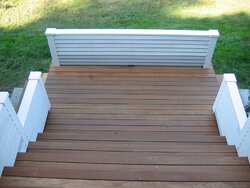I'm planning on putting down new decking boards to replace my existing cracked, cupped and worn decking. My deck is 25 years old and it has lasted a pretty long time. The foundation boards/joists seem solid so my plan is to pop up a few boards at a time and nail down new replacement boards.
A couple questions...
What's the trick to nailing boards at the end without splitting? I always split boards when I nail or screw them down at the end. Predrilling would help but I don't see other folks needing to do this.
I considered some of the modern decking boards made of various plastics but have decided against it due to cost. This is just a facelift top decking job and not a total deck rebuild (I would use them for a total redesign). These top decking boards won't be in contact with soil so is it Ok to use non-treated boards? I think my Lowes has kiln dried deck boards that are not treated.
Thanks for any advice!
A couple questions...
What's the trick to nailing boards at the end without splitting? I always split boards when I nail or screw them down at the end. Predrilling would help but I don't see other folks needing to do this.
I considered some of the modern decking boards made of various plastics but have decided against it due to cost. This is just a facelift top decking job and not a total deck rebuild (I would use them for a total redesign). These top decking boards won't be in contact with soil so is it Ok to use non-treated boards? I think my Lowes has kiln dried deck boards that are not treated.
Thanks for any advice!




